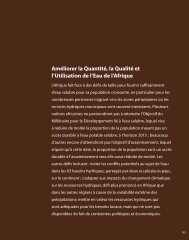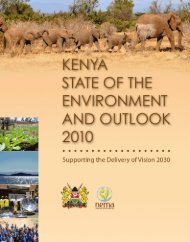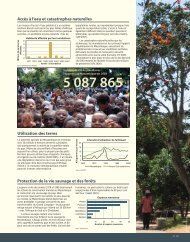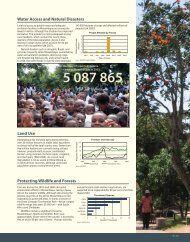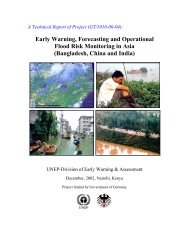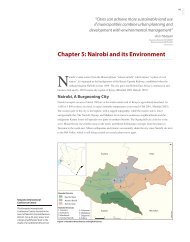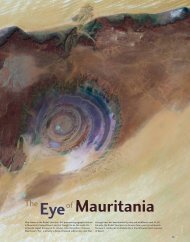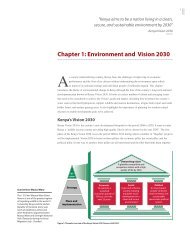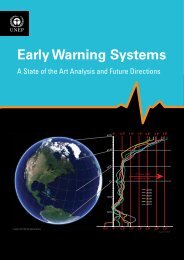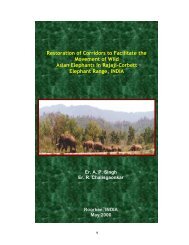Uganda Atlas of Our Changing Environment - GRID-Arendal
Uganda Atlas of Our Changing Environment - GRID-Arendal
Uganda Atlas of Our Changing Environment - GRID-Arendal
You also want an ePaper? Increase the reach of your titles
YUMPU automatically turns print PDFs into web optimized ePapers that Google loves.
Lake Mutanda: Heavily converted Gitundwe wetland in Nyundo and Nyakabande sub countries (2008)<br />
heavily Lake converted Mutanda Gitundwe wetland in Nyundo and Nya<br />
Source DSOER Kisoro 2008<br />
This emphasizes the local, regional and international<br />
importance <strong>of</strong> lakes Bunyonyi and Mutanda and, their<br />
catchments and the various wetland systems fringing these<br />
water systems, as one whole ecosystem whose degradation<br />
will have serious on-site and <strong>of</strong>f-site implications.<br />
<strong>Environment</strong>al Change and effects<br />
Population pressure on land and poor land management<br />
practices have led to clearance <strong>of</strong> every bit <strong>of</strong> vegetation<br />
cover in the lake catchments leading to grave accelerated<br />
erosion. In the past, efforts were made by Government to<br />
institute and enforce soil and water conservation measures,<br />
and by 1950s this region was graded to attained soil and<br />
water conservation standards, particularly bunding and<br />
terracing on farmlands, easily unsurpassed anywhere<br />
else in Africa. However, the ever mounting challenges <strong>of</strong><br />
rapid population growth coupled with later relaxation<br />
in enforcement <strong>of</strong> conservation measures has left the<br />
98<br />
lake catchments and the rest <strong>of</strong> the highland region in a<br />
desperate state, with conservation structures on farmlands<br />
and hillslopes in general disintegration from hyperaccelerated<br />
erosion (Bagoora, 1993).<br />
In the areas surrounding Lake Bunyonyi and Mutanda, the<br />
population is estimated to be beyond 350 persons/km2 making it one <strong>of</strong> the world’s most densely populated rural<br />
areas; with projections <strong>of</strong> continued high growth rates <strong>of</strong><br />
more than 3% per annum, which does not in any way point<br />
to a rosy future.<br />
Landuse is dominated by peasant farming based on annual<br />
crops dominated by sorghum, potatoes and legumes, which<br />
leads to disturbance <strong>of</strong> the soil continuously and provide<br />
poor cover and protection to soil from erosion. Although soil<br />
loss from these slopes has not yet been properly quantified,<br />
it could be within the magnitude <strong>of</strong> 155 tons/ha/year on<br />
District State <strong>of</strong> <strong>Environment</strong> Report Kisoro (2008)



